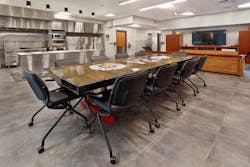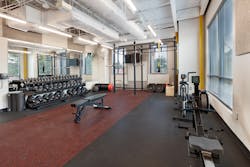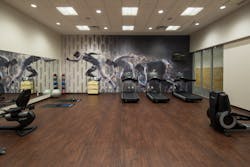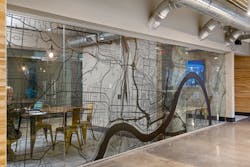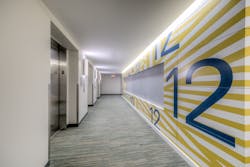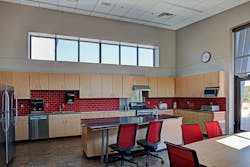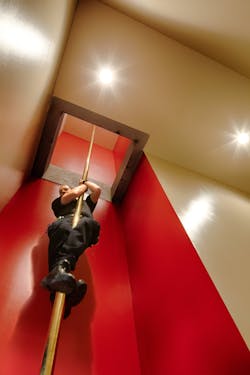Newest Concepts to Promote Camaraderie & Mental Health
Constraints, but not constraining
Good design sometimes can feel unattainable when cost and performance are at the forefront of design thinking.
For example, many departments’ design standards support the health, safety and welfare of members by outlining the performance, durability and maintenance requirements of interior finishes. Furthermore, those requirements must be accomplished within a very tight budget, with consideration given to both material costs and installation costs. Material availability is a concern as well, with many projects defaulting to U.S.-based manufacturers.
When working under these constraints, it’s easy to feel limited and, thus, to default to the basic approach—painted walls, brown rubber wall base, concrete or vinyl composite tile flooring and acoustic tile ceilings with troffer lights. Fortunately, the market has come a long way recently, and, suddenly, many finishes that are, shall we say, interior designer-friendly yet deliver on performance and don’t break the budget are readily available. Trusted manufacturers increasingly offer more such options for furniture and finishes, which give design teams a wider range of possibilities to create more communal, welcoming spaces in public-safety facilities.In the same vein, the colors, textures, patterns, and graphics of finishes and furniture can have a huge effect on creating a much livelier space. Take color: Some departments use fire engine red for their fire and emergency apparatus. Some use safety yellow. Others have their own unique color. In any case, incorporating that color through simple things, including high-performance metal paint for doors and railings as well as durable acoustic wall panels in apparatus bays, provides liveliness to “action zones.”
Performance of finishes and furnishings
Quality, durability and ease of maintenance for finishes and furnishings don’t have to come at the cost of interior design. The right manufacturer or installation can increase design options and create a more dynamic facility.
Accent walls, wall protection coverings or fun base materials, such as diamond plating, help to liven up a space. A change in flooring from one room to the next, whether by material, pattern or color (i.e., porcelain tile in the kitchen to carpet in the dayroom, or specs of red in the free weights area of a physical conditioning room and all-black in the treadmill section) might be used to define space.For high-traffic corridors, many U.S. manufacturers have begun to offer more options for wall protection and hard-surface flooring, such as wood-look wall protection and wood-look porcelain tiles. These can be used to provide a reminder of nature, reduce the scale of a space and define public versus private space. This can create a more welcoming, yet durable, atmosphere.
The incorporation of ceiling soffits, exposed ceilings with acoustic (sometimes colorful) baffles or acoustic tile ceiling clouds create “destinations” within a facility. Classic, midcentury modern and contemporary furnishings that have visual textures, pops of color or custom components can help to ground an area.
Millwork is another easy customization and can be a great focal point in dayrooms, office spaces and kitchens. Regarding the latter, a kitchen island can be a particularly effective design element, with a different color cabinet or countertop than other colors in the room, an adjacent decorative ceiling, lighting treatments and even an old ladder-turned-pot rack.Large-scale graphics can feature a station patch, a photograph of apparatus or a collage of historic images. They are easy to install even in retrofit solutions. Physical conditioning rooms, the walls of apparatus bays, spaces in museum and corridors are good locations for this type of custom art.
Design team qualifications
Working with a fire station architect who has experience with your building type and who understands performance, quality and budget requirements is important. However, this expertise should be complemented by a fire station interior designer who thinks outside of the box to develop a design that promotes camaraderie and good mental health, without a negative effect on performance, quality and budget.When you are in the process of selecting a design team, it’s important to ask questions that go beyond adherence to budgets, project management approaches and previous project performance. Ask questions about how the firm supports design decisions to promote camaraderie and good mental health. What types of materials does the team suggest to produce performance over time but also offer unique design options? Ask for examples of work that provide these expressions. If a firm can’t provide examples or jump into a discussion about incorporating camaraderie-building and mental wellness into design, this might be a red flag.
A new design day
Until recently, it was challenging to extend health, safety and wellness initiatives to the interior design of firehouses through finish and furniture. Now that low-cost high-performance materials are available in a diverse palette, bringing life to communal spaces and furnishings cost-effectively no longer is unattainable.About the Author
Margaret Lafferty
Margaret Lafferty is a senior interior designer and senior associate for BKV Group Architects and Engineers. She is a licensed commercial interior designer in the state of Minnesota, where she leads the firm’s government interior design both locally and nationally. Lafferty holds a Bachelor of Science in interior design.
